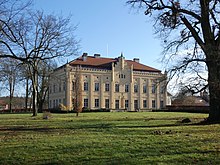Nennhausen Castle
Castle Nennhausen is a castle-like developed mansion in the village Nennhausen west of the country Brandenburg . The manor belonged to the Nennhausen manor . Together with the Nennhausen Palace Park , it forms an ensemble that is rare in its condition in Havelland . Alexander von Stechow (1938–2020) acquired and renovated Nennhausen Castle together with his wife Benita in 1996.
history

1686, the family acquired von Briest the manor Nennhausen by the family of Lochow . The castle was built in 1705 using pre-existing foundations . In 1735 extensive renovations and extensions began, which lasted at least until 1738. Nennhausen Palace was redesigned as a three-wing complex in the Baroque style. The builder was Friedrich Christoph von Briest.
Between 1803 and 1831 the poet Friedrich de la Motte Fouqué , who was married to the born Caroline Philippine von Briest , widowed von Rochow , lived at Nennhausen Castle during the summer months. Some well-known personalities were guests at Nennhausen Castle in the early 19th century. For example, Adelbert von Chamisso , August Wilhelm Schlegel , Karl August Varnhagen von Ense and Ernst Theodor Amadeus Hoffmann spent some time at de la Motte Fouqué. Friedrich de la Motte Fouqué wrote his Undine in the manor park , which was set to music by ETA Hoffmann.
After de la Motte Fouqué's father-in-law Philipp von Briest died in 1822 and the von Briest family died out, Nennhausen passed by inheritance to the von Rochow family. In the middle of the 19th century there were again extensive alterations to the castle. The drafts came from the court building officer Ferdinand von Arnim . During these reconstructions, the north wing was torn down and the south wing was raised. The L-shaped building was given a plastered facade and decorative elements that are typical of the historicist New Tudor style . After 1859 ownership of the estate changed more frequently. In 1928 the manor district was finally dissolved. At that time, the owner of Nennhausen Castle was Egon Reichsgraf von und zu Westerholt and Gysenberg. In 1928 the estate was 1371 hectares in size . At the end of the war in 1945, Nennhausen Castle and the 827 hectare estate were expropriated as part of the land reform . The building was initially used as a refugee home and later as a school. In the following years other uses were the savings bank , cultural center, kindergarten, library, community administration and registry office . In 1983 there was a fire on the roof of the castle during construction work. The ruin had been left to decay for almost ten years. In 1990 the castle was designated as a monument . It was not until 1992 that more extensive security measures were taken. Nennhausen Castle has been owned by the von Stechow family since 1997 . From 2001, extensive renovations were carried out on the facility. Nennhausen Castle is used as a private residence, but also as a cultural site.
manor
Nennhausen Castle is a two-winged building. The main and southern side wings have two floors. The plaster is yellow in color. In the main wing to the main courtyard is a segmentbogig designed portal . Above this there is a coat of arms stone with the coat of arms of the builder Friedrich Christoph von Briest. Staggered gables are conspicuous, over three to the courtyard and over two window axes with turret-like gables to the park . A large, double coat of arms is incorporated under the gable of the main courtyard. The heraldic right is the coat of arms of the von Stechow family, the heraldic left is that of the von Menges family. The facade is designed with pilaster strips and cornices . Furthermore, the windows have light Verdachungen on from plaster. The eaves are crenellated . The side wing to the east has a similar stepped gable to the center of the main wing. There is a weather vane on a central gable . The roofs are mansard roofs with a loft . They are covered with red beaver tails .
Manor or castle park
The manor or palace park has a size of about 40 hectares. It goes back to de la Motte Fouqué's father-in-law, Philipp von Briest. The central areas were laid out as an English landscape garden between around 1780 and 1822 . A tree around 400 years old was named Fouqué oak before it collapsed in 2006 and has only existed as a ruined tree since then. A vase monument commemorates Ludwig von Briest, a brother of Philip. In the second half of the 20th century, after it was expropriated as part of the land reform, the park became overgrown. It was only gradually restored to its shape from 1990 onwards. Nennhausen Palace with its park is the only restored ensemble in the Havelland district alongside Paretz Palace . The former orangery , a small building, has been expanded in the park. In 2015 ten clay sculptures and reliefs by the sculptor Dirk Harms were installed in the palace gardens.
Web links
- http://www.schloss-nennhausen.de/ Schloss & Park Nennhausen
Individual evidence
- ^ Alexander von Stechow obituary , FAZ from March 12, 2020
- ^ "Mourning in Nennhausen: Alexander von Stechow is dead" , Märkische Allgemeine from March 6, 2020
- ^ Sebastian children, Haik Thomas Porada (ed.): The Havelland around Rathenow and Premnitz . Values of the German homeland . Böhlau, Cologne / Weimar / Leipzig 2017, ISBN 978-3-412-22297-0 , pp. 258-261.
- ^ Sebastian children, Haik Thomas Porada (ed.): The Havelland around Rathenow and Premnitz . Values of the German homeland . Böhlau, Cologne / Weimar / Leipzig 2017, ISBN 978-3-412-22297-0 , pp. 260-261.
- ↑ Heiko Hesse: The wind animates the conversation. In: Märkische Allgemeine. May 12, 2015, accessed February 8, 2019 .
Coordinates: 52 ° 36 ′ 19.8 " N , 12 ° 30 ′ 12.8" E


